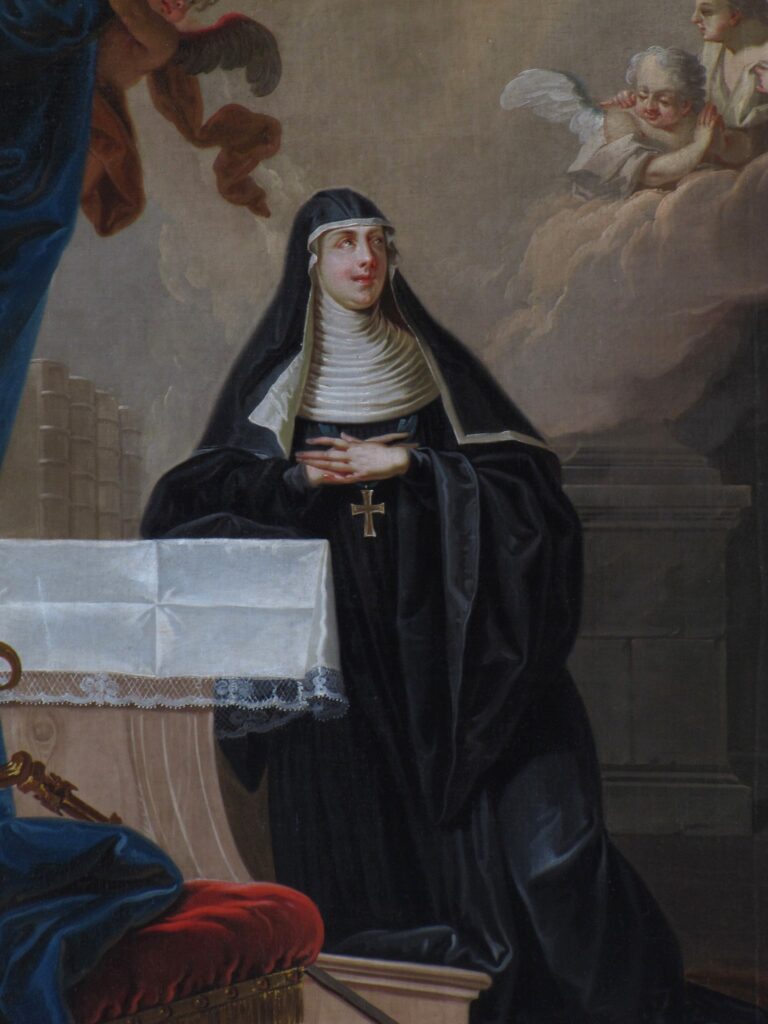As Lent approaches, St. Elizabeth Ann Seton and St. Scholastica remind us to examine our hearts and prioritize and cultivate a fervent desire for God.

Altar of Saint Scholastica (1781): Painting “Saint Scholastica” (Franz Joseph STOEBER, oil on canvas, 158×90, 1781).
Lent is nearly upon us. That means penance, abstinence, suffering.
Or so we might think.
If thinking about Lent this year is making you feel down, oppressed—like all those practices and sacrifices are just another thing to “do” on top of everything else—it is time for a reboot.
Let us return to the basics. Lent is the preparation for Easter. It is the heart’s oblation, the winnowing away of all that holds us back from Easter joy. And Easter is the offering of Christ’s unimaginable life to us.
But we have already received that life in us at baptism—which means that Lent is about discovering a gift that is already given, something that is happening in our lives here and now. It is about encountering Christ who gives himself to us today.
And the most natural response to this gift is prayer.
But what about prayer? Does that sound hard, as well? Is it overwhelming? A chore?
Remember when you first fell in love? Was it “work” to talk to that person, “work” to find time for them? Prayer is being with the One whom you love. So, if prayer is work, then we need to take one step back from that, too. We have to go inside ourselves to listen to the cry of the heart. We have to discover our need for Christ.
Such need was the driving force for Scholastica, the Sister of the great monastic founder, Saint Benedict—and that is practically all we know about her, the one little story that illustrates her entire life.
As Saint Gregory the Great tells it, Scholastica lived in a convent quite close to her brother’s famous monastery at Monte Cassino in Italy. Once a year, brother and sister would meet for a day of spiritual conversation in a little house in between.
The very last time they did this, shortly before Scholastica died, she, perhaps having a foreboding of her coming death, begged her brother to stay longer than normal, to talk with her into the night. But Benedict insisted that he had to go. The monastic rule (the very one he wrote) stipulated that he was not to be outside of the enclosure of the monastery after dark.
When she heard these words, Scholastica leaned her head forward on her hands and prayed. Suddenly, a thunderstorm blew up that was so violent that there was no way Benedict could leave the hut. He turned to his sister in his irritation. “God forgive you, what have you done?” he asked her. And she replied, “I desired you to stay, and you would not hear me; I have desired it of our good Lord, and he has granted my petition.” Benedict was stuck, and he remained the rest of the night and talked with Scholastica.
Reflecting on this, Gregory concedes that the miracle wrought by Scholastica in that moment was greater than what Benedict could do. And the reason why? “God is love” and “she who loved more, did more.”
But how precisely did Scholastica best her brother in love? I do not think we can make this about “people versus rules,” as though Scholastica’s desire for time together with her brother trumped Benedict’s sense of attachment to the rules of the monastery. After all, the Benedictine Rule was nothing if not a way to form men and women in charity.
No, I think something different is going on here. What we need to pay attention to is how Scholastica solves problems. In what does she find her strength? In a moment in which she wants to spend more time with her brother, she does not jump on Benedict to give her what she wants, but rather seeks an answer in prayer. She consults her own heart and then utters a cry to the One who loves her.
Saints are those who confess their raw need, who cry out constantly for the love of God. This is the motivating force, the energy that drives them. It is this poverty that draws God’s mercy upon them, as suddenly and swiftly as that thunderstorm blew in.
It is worth noting that our first canonized American saint was an impoverished widow who was, historically speaking, flanked by powerful men who were overseeing dioceses and founding educational institutions. But Elizabeth is the one whom God graced. A poor woman with mouths to feed was the vessel for God’s love, communicated through her charity then and radiated even today by the Sisters who are her spiritual daughters.
All of this came from Elizabeth’s seeking the Lord. The source of her sanctity was the unfailing, almost crazy, desire she had for him. It is the constant theme of her life and her writing.
Elizabeth, like Scholastica, shows us the way. You cannot meet these women without being struck by their desire, this relentless energy directed at the One who made them and loves them.
This Lent, let us follow them. Do we know this love to be the center of our existence? And if not, what is standing in the way?
LISA LICKONA, STL, is Assistant Professor of Systematic Theology at Saint Bernard’s School of Theology and Ministry in Rochester, New York, and a nationally-known speaker and writer. She is the mother of eight children.
Source: https://setonshrine.org/





0 Comments